
On April 30, six Hong Kong virtual asset spot ETFs were listed on the Hong Kong Stock Exchange, officially ushering in their first market appearance.
A week ago, the official website of the Hong Kong Securities Regulatory Commission (SFC) listed the Bitcoin and Ethereum spot ETFs of three fund companies, Huaxia Fund (Hong Kong), Bose International and Jiashishi International, and successively disclosed issuance information.
In terms of issue price, the issue price of products under Jiashen International and Huaxia (Hong Kong) is US$1 per share (HKD 7.827), and the initial issue price of Bose Bitcoin ETF and Ethereum ETF is 1 of the tracked index on April 26, 2024 respectively./10000 and 1/1000 are basically the same. Holding 10,000 shares is approximately equal to 1 Bitcoin, and 1,000 shares is approximately equal to 1 Ethereum.
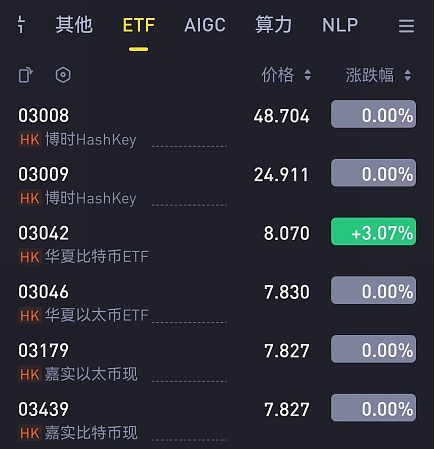
Opening prices of 6 ETFs, source: Public information
Judging from the results of the debut, the performance of Hong Kong ETF can only be said to be unsatisfactory.As of the closing, the transaction amount of the first six Bitcoin and Ethereum spot ETF funds launched in Hong Kong was only HK$87.58 million, and most ETFs fell below the opening price. Taking the largest China Bitcoin ETF as an example, it opened at 8.07.Hong Kong dollars, only HK$7.95 when the market closed.A sharp contrast is that the trading volume of 11 spot Bitcoin ETFs in the United States reached US$4.6 billion in the first trading day, about 383 times that of Hong Kong on the first day.
Since Hong Kong issued its virtual asset declaration, the crypto industry has high hopes for Hong Kong. Now, a year has passed, and Hong Kong has taken a big step, but the result is still dull. “Thunder loudly and raindrops” has become the market for Hong Kong Web3The joke of .
In fact, this situation has long been revealed. As early as April 15, when the first batch of virtual asset ETFs were publicly announced to be approved, the industry’s discussions on them were mixed.
Although major mainstream media platforms call it a historic event, the market has obvious heel tickets, and the prices of Bitcoin and Ethereum have both maintained fluctuations and even slightly declined, which is very little affected by this news.In the previous speculation of Bitcoin spot ETFs in the United States, whether it was through the soaring of the previous market, or the short-term decline of Bitcoin afterwards, and even Bitcoin broke through new highs, all showed the huge influence of the United States on the crypto market.This kind of influence is undoubtedly difficult to achieve in Hong Kong.
The root cause of difficulty lies in the scale of funds.Since the news of the approval of Hong Kong spot ETFs has been reported, the market has had many different opinions on the capital flow of ETFs.Eric Balchunas, senior ETF analyst at Bloomberg, publicly stated on the X platform that all virtual assets in Hong Kong are as large as the market size of Hong Kong’s ETFs is only about US$52 billion, coupled with the shortcomings of approved institutional fund management restrictions and insufficient basic ecological liquidity in Hong Kong.If spot ETFs can attract $500 million, they are already performing well.
Some industry insiders also objected to this, believing that the Hong Kong ETF market has significant institutional effects and high awareness of virtual assets, and may not be without a chance to turn things around.Compared with gold ETFs, the SPDR GOLD TRUST AUM in the Hong Kong market reached US$69.8 billion, which shows that Hong Kong is highly optimistic about anti-inflation assets with high recognition.Another example comes from Chainalysis, which is estimated to drive US$64 billion in trading volume from June 2022 to June 2023.In this regard, OSLETF project leader Wayne Huang believes that this ETF should attract at least $1 billion, while Paolo of crypto exchange VDX even believes that it can introduce $10 billion this year.
Judging from the current trading situation, the transaction scale is still difficult to be optimistic, with the trading volume on the first day not reaching 100 million yuan. Observing the futures ETFs listed in Hong Kong, the three ETFs only attracted capital inflows of HK$529 million.Of course, given the limitations of futures, this data can only be used as a lower limit valuation.
Returning to the essence, the market cares most about whether the southbound funding channel can be opened based on the analysis of the scale of funds.Mainland Chinese capital and Hong Kong to invest in stocks in the other markets need to go through the Shanghai-Hong Kong Stock Connect or the Shenzhen-Hong Kong Stock Connect, which is also known as the categories of southbound funds (Mainland China to Hong Kong) and northbound funds (Hong Kong to Mainland China).In short, the flow of money from the mainland into Hong Kong is the key to the rise of Hong Kong’s cryptocurrency.
Even the core ETF participants have no positive answer to this question.The primary compliance of ETFs comes from underlying assets. Currently, Hong Kong spot ETFs are targeted by virtual assets such as Bitcoin and Ethereum. Virtual asset transactions are strictly prohibited in the mainland. Therefore, in the mouths of many issuers, it is difficult for southbound funds to purchase ETFs..Caixin also reported on this, saying that according to a joint circular issued by the Hong Kong Securities Regulatory Commission and the Hong Kong Monetary Authority in December 2023, whether it is the virtual asset futures ETF currently available in the Hong Kong market or the virtual assets to be issued in the future.Spot ETFs cannot be sold to retail investors such as mainland China who are prohibited from selling virtual asset-related products.
There are no exceptions. Mainland people holding Hong Kong ID cards, even if they are not permanent residents of Hong Kong, can participate in the transactions of the above ETFs under compliance.Based on this information, mainland institutions or mainland people holding ID cards from both places also have the opportunity to participate. It is still difficult to clarify whether there is a gray area during the period.But a rather ambiguous proof is that the currently approved spot issuers of virtual assets can see the figure of Chinese capital from it, and in addition to the Hong Kong dollar and US dollar counters, the two ETFs under China also have additional RMB counters.
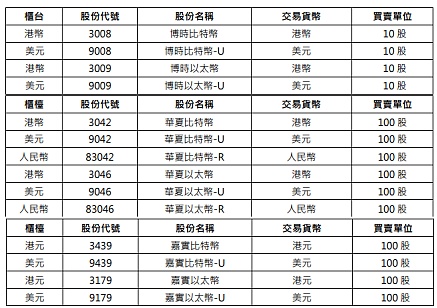
Issuance data of 6 ETFs, source: Public information
But from the practical operation of mainland users today, mainland investors will be prompted to refuse transactions by pop-up windows to buy ETFs.Therefore, in terms of the current situation, the influx of southbound funds is still difficult, and offshore funds and local capital will become the main areas for the sales of Hong Kong’s virtual asset spot ETFs.
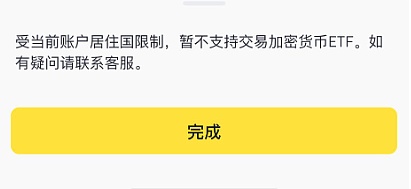
Pop-up window for mainland users on Tiger Securities, source: X platform
Outside of scale, there are still many problems in Hong Kong’s local crypto market.The high cost and narrow market make it difficult for Hong Kong to emerge with a huge technological ecosystem and make it even more difficult to discover large-scale application projects. As a fund exchange channel, it is obviously more in line with Hong Kong’s positioning, but this channel is not only subject to regulatory restrictions, but also facesChallenges from other markets, such as the option of offshore capital to choose cheaper overseas exchanges, which directly leads to a nearly plain market reaction.
Even though the market is not optimistic, the ETF itself obviously has more far-reaching significance for Hong Kong, a financial center.Although Hong Kong officials severely refuted the remarks of the financial center site and the data also prove that Hong Kong has significant advantages in markets such as bonds and wealth management, as well as in sub-sectors such as banks and insurance, it has to be admitted that in recent years, the macro environment has been tightened overseas.Under multiple factors such as market rise, Hong Kong still faces pressure in international competitiveness.
Taking the most controversial stock market as an example, insufficient liquidity of Hong Kong stocks has become a recognized fact. Data shows that in 2023, the number of IPOs on the Hong Kong Stock Exchange was 73, a year-on-year decrease of 19%. The total amount of IPO funds raised reached HK$46.295 billion, a year-on-yearThe 56% reduction not only hit a ten-year low, but Hong Kong stocks fell out of the top five IPO markets in the world, but 36 of the 73 listed new stocks broke the issue price on the first day, with a break rate of 51%.
Against this background, virtual assets, as the main representative of the foreseeable financial sector of digital assets, are self-evident in the importance of the international financial center.In this regard, the United States’ virtual asset ETF has given an example. In just less than 4 months, the asset management scale of 11 Bitcoin spot ETFs in the United States has exceeded US$52 billion.As of now, Hong Kong’s efforts have not been completely in vain.At least in terms of regional competition, except for the US’s first superstar, Dubai, Singapore and Hong Kong have shown signs of a three-legged stalemate. The proven capital flow and people flow are slowly flowing into Hong Kong with the establishment of the ecosystem and the listing of ETFs.
From an industry perspective, Hong Kong’s approval of ETFs has a significant role in promoting the compliance of virtual assets and has also added impetus to the development of Hong Kong’s crypto industry.Specifically, ETFs have greatly improved the convenience of investors for purchasing. Products that were previously required to open an account on a compliant exchange can be directly traded through securities accounts and banks after the ETF is listed, and retail investors can use them directly., and indirectly through ETFs, institutions or funds that are difficult to directly invest in virtual assets can also be involved in it through ETFs.
“Investors in Hong Kong can buy ETFs like they buy stocks. Now IBB, Tiger, Victory, etc. can support the purchase.” said a Hong Kong worker.In contrast, purchasing US virtual asset ETFs must be a professional Hong Kong investor and have an investment amount threshold.
It is worth mentioning that Hong Kong’s acceptance of physical redemption has enabled virtual asset ETFs to have a more flexible trading model in the transaction process, supporting currency inflow, currency inflow, currency inflow and currency inflow, compared with the United States.Only allowing cash redemption of money to be in and out has added more arbitrage mechanisms and is also conducive to encrypting the participation of native users.
Returning to the ETFs listed this time, the rate war that was originally launched in the United States was also restarted in Hong Kong.
Since the underlying assets tracked are the same, investors will focus on expense ratios and liquidity when choosing ETFs.Theoretically, the ETF fee ratio on the Hong Kong side should be higher than that of the United States. The reason is that the compliance costs of the Hong Kong crypto exchange are higher than those of overseas. For example, in addition to fixed costs such as operation and maintenance, technology, RO, and data tracking, there are also linear increases.Insurance fees for custodial assets.The high cost of this type of invisible coin listing fee can be seen from the coin listing fee. According to official data, HashKey Exchange, which has relatively weak liquidity, estimates that the coin listing fee ranges from 50,000 to 300,000 US dollars, while Coinbase claims that it does not charge the coin listing fee.Coin application fee, but the company reserves the right to charge this fee to pay for service fees during the evaluation and listing process.
The facts are also consistent with the data, according to the product summary,The ETF products of the three institutions are all higher than the same ETF levels in the United States, among which,Huaxia’s ETF product cost ratio is the highest, reaching 1.99%, while Chiashi and Bose are 1% and 0.85% respectively.
From the current perspective, Hong Kong has made some choices in terms of management fees in order to attract funds, and major issuers are all hoping to gain a scale advantage with lower management fees.According to statistics, the management expenses of the three funds are 30 basis points for Jiashi International, 60 basis points for Bose International and 99 basis points for Huaxia Fund respectively.Among them, the management fee will be exempted within 6 months of holding the products of Jiashishi International, the management fee will be exempted within 4 months of the issuance of the products of Boshi International, and the internal evaluation management fee rate of Huaxia can be reduced to 65 basis points.
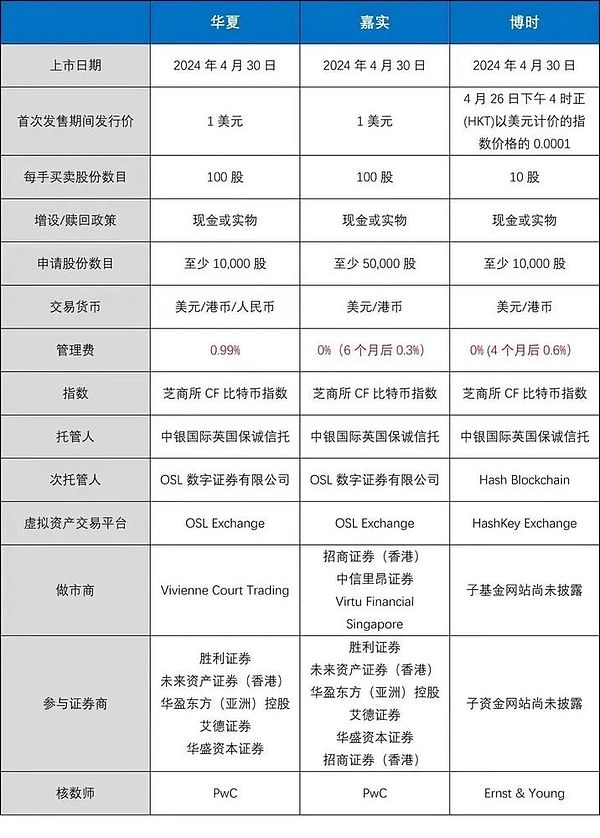
Comparison of three issuing institutions, source: TechubNews
Compared with the United States, the management fee rate of Hong Kong ETFs is still slightly high and does not have core competitiveness.According to the data, except for Grayscale and Hashdex, the remaining nine approved Bitcoin ETFs in the United States have a fee rate of between 0.19% and 0.49%, while the iShares rate of representative product BlackRock is 0.25% and the firstIt was only 0.12% in 12 months.But it is worth mentioning that even though the grayscale fee rate is as high as 1.5% and funds continue to flow out in recent months, it is still the ETF institution with the highest asset management scale, which indirectly reflects the importance of liquidity to the ETF itself.
Reflecting the actual transaction data, the Huaxia head effect, which has high fees but has the advantage of asset management scale, shows.Data shows that the initial public offering scale of Huaxia Bitcoin ETF and Huaxia Ethereum ETF were HK$950 million and HK$160 million respectively, while the Huaxia Group accounted for nearly 57% of the trading volume on the first day.
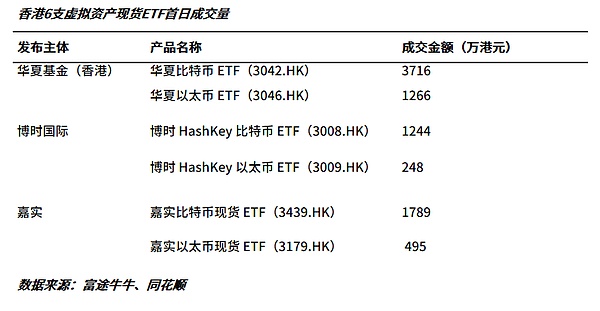
Although it seems to be in danger, Hong Kong, perhaps from the beginning, had expected this situation.
A head of a Hong Kong crypto exchange said, “There is no way to compare with the United States, but compared with similar products in Europe, Canada, Switzerland and other regions, Hong Kong still has an absolute advantage. Hong Kong can also be a fulcrum, facing Southeast Asia, Taiwan, and evenFor the development of the Middle East region, traditional funds will enter as appropriate after compliance. There will definitely be ETF markets, but there will be difficulties in the rise of Hong Kong Compliance Exchange in the short term.”
From a differentiation perspective, in addition to the more active funds and the advantages of physical asset subscription, Hong Kong’s strict compliance has also built a safer and more controllable trading environment.Taking insurance as an example, according to the regulations of the Hong Kong Securities Regulatory Commission, crypto exchanges must insure all custodial assets, and user assets need to be separated from hot and cold. 98% are placed in cold wallets, and only 2% are placed in hot wallets. If the cold wallet is lost, the cold wallet can be lost.Get more than 50% of the compensation, and get full compensation if the hot wallet is lost.Against this background, traditional capital in the Asia-Pacific region, which is highly concerned about risks, can also enter the market with confidence.
Another advantage is Ethereum spot ETF.At present, the US Ethereum spot ETF is still in the game, and the news is false and real, and there are arguments to support whether it is passed or not.From the perspective of passage, most people insist that the SEC finds a reason to refuse in the context of the passage of Ethereum Futures ETFs, and the Whale account led by Justin Sun has gradually begun to increase its holdings in ETH.But from the perspective of rejection, Ethereum’s securities nature and SEC’s tough attitude made the market feel hesitant.Recently, according to four people familiar with the matter, US issuers and other companies expect that the US Securities and Exchange Commission will reject the application for Ethereum spot ETF. It is said that after the issuer talks with the SEC, the SEC’s attitude flashed and the staff did not discuss the relevant situation.The execution details of this financial product are in stark contrast to previous intensive and detailed discussions about Bitcoin spot ETFs.
This may also bring certain opportunities to Hong Kong’s ETFs.When the ETF was approved, Hong Kong approved two spot products, Bitcoin and Ethereum, which directly filled the gap in Ethereum ETFs in the United States. Although according to today’s data, ETH products are only about HK$20.09 million.Trading volume.
Considering various reasons, issuers are still very confident, and Huaxia Fund purchased up to US$1 billion in insurance for its assets, indirectly reflecting expectations for market size.Han Tongli, CEO of Jiashi International, even said in an interview, “Hong Kong ETF should not be worse than any ETF in the United States, and it will even surpass the United States.”
At present, there are market rumors and figures for the inflow of ETFs of 500 million, 1 billion, 10 billion or even 20 billion US dollars, but only from today’s market performance, no matter which data it is, it still needs to be tested by time..
What is quite interesting is that looking at Hong Kong’s encryption from different nodes will get completely different results.When the 2022 declaration was released, everyone in the market gave Hong Kong a public hope, and the rise and fall of the east was launched.After the new license regulations were promulgated in 23 years, the compliance costs and strict supervision made the exchange admit that “dance in shackles” and the market popularity quickly declined, and ignorance and wait-and-see attitudes became attitudes.And then to the listing of virtual asset ETFs this year, mixed opinions began to emerge.The only thing that remains stable is that at every node, the Hong Kong crypto sector rises, and the news seems to have become a signal of speculation in the secondary market.
In response, a friend laughed and said, “Is it because we expect too much from Hong Kong, and we give back too little?”
It’s too early to say this.In previous articles, the author quoted the number of coins to describe the current Hong Kong crypto industry. In fact, even if you don’t need to describe it deliberately, you know that Hong Kong’s crypto industry is difficult and slow after 17 or 18 years of ecological loss.Entering a new era of compliance, the competition between compliance exchanges, offshore exchanges, securities institutions and the competition among all heroes has just set sail. Whether in public education or market cultivation, Hong Kong is in its early stages.
At the next node, looking at Hong Kong, what position will the crypto industry occupy?The problem is still unknown.But from the current situation, Chinese Web3 will always occupy a place, and the Asia-Pacific market is ultimately one of the key markets of encryption. It requires windows and fulcrums to carry this market and group, not to mention that there may be a large-scale digital asset exchange in the future.From this point of view, the future of Hong Kong encryption is still very big, at least, much larger than the data you see now.
The footnote of history has been decided, and the future of Hong Kong Web3 is coming in a staggering manner.








